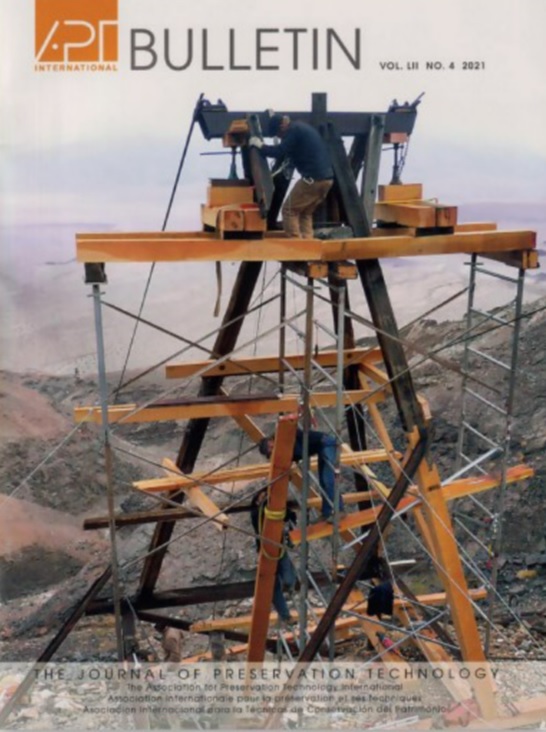The Association of Preservation Technology Bulletin (Vol LII, No 4, 2021)
The Association of Preservation Technology Bulletin (Vol LII, No 4, 2021) is another thematic one, focusing on wood as a building material. Articles cover wood-conserving projects at a wide range of locations and scales.
Suzana Radivojevic and Chad Randl kick off the edition with a discussion of the importance of plywood in 20th century architecture and housing, and the need for heritage professionals to develop strategies for assessment and conservation. Plywood structural assemblies, finishes and decorative elements are increasingly being considered for their historic significance on national and international heritage lists. It is imperative that heritage professionals develop appropriate evaluation strategies and conservation treatments for historic plywood panels. Specifying appropriate like-for-like contemporary replacement panels, especially for plywood fabricated prior to the 1960s, can be difficult because of changes in production and performance standards.
The authors give a helpful history of plywood and its particular properties, and describe a method of assessing the condition of exterior panels, based on three case studies commissioned between 2017 and 2021. The authors conclude that plywood remains in an early phase of study, documentation and research. The importance of material analysis in architectural conservation is well established, but the analytical methods and protocols for investigating historic plywood are lacking, and clear guidelines for the identification, evaluation and treatment of historic plywood panels are yet to be established.
In a second paper, Ronald W Anthony and Brian D Aschim explain the functions of open-web wood trusses and how they behave under unanticipated loading conditions. These structural framing systems were often used to support the roofs in large buildings that may now start to be considered for statutory protection. The authors explain the factors affecting truss and design factors in loading conditions that can also affect this. They point to the importance of the hardware that connects the trusses together, before setting out five considerations necessary for the assessment of open-web trusses if failures are to be avoided.
Considerations for the use of purified linseed oil on historic wood are considered by Erin Gibbs and Katherine Wonson. Their paper, geared towards professionals unfamiliar with the treatment, sets out the advantages and disadvantages of using this fluid. The authors set out the qualities of linseed oil versus the characteristics of modern coatings and linseed oil paints, and the experience gained since 2012. They conclude that purified linseed oil systems are a promising preservative treatment and a viable option for use on historic wood resources. But they are not a preservation panacea, and when selecting linseed oil paint users must understand what they need and what they are buying. Good specifications are the key to acquiring and applying the optimal product for any given project.
Although wood shingle roofs are uncommon in the UK (referenced in just over 500 listings in England, they are sometimes found on church steeples, for example) they are widely encountered in America but vulnerable and particularly threatened by incidences of wild fires. The paper from Samuel Zabb-Parmley may have some interest to those who may need to consider fire risk, damage and protection (if not wild fires).
This article originally appeared in the Institute of Historic Building Conservation’s (IHBC’s) Context 172, published in June 2022. It was written by Bob Kindred MBE.
--Institute of Historic Building Conservation
Related articles on Designing Buildings
- Association of Preservation Technology Bulletin Vol LIII, No 1, 2022.
- Coal holes, pavement lights, kerbs and utilities and wood-block paving.
- Conservation.
- Heritage.
- IHBC articles.
- Institute of Historic Building Conservation.
- Listed buildings.
- The Association of Preservation Technology Bulletin Vol LIII, Nos 2–3, 2022.
- Violet Pinwill, woodcarver.
- Worcester timber buildings and the Commandery.
IHBC NewsBlog
Southend Council pledge to force Kursaal owners to maintain building
The Council has pledged to use ‘every tool in the toolbox’ if urgent repairs are not carried out.
HE’s Research Magazine publishes a major study of the heritage of England’s suburbs
The article traces the long evolution of an internal programme to research 200 years of suburban growth
IHBC Context 183 Wellbeing and Heritage published
The issue explores issues at the intersection of heritage and wellbeing.
SAVE celebrates 50 years of campaigning 1975-2025
SAVE Britain’s Heritage has announced events across the country to celebrate bringing new life to remarkable buildings.
IHBC Annual School 2025 - Shrewsbury 12-14 June
Themed Heritage in Context – Value: Plan: Change, join in-person or online.
200th Anniversary Celebration of the Modern Railway Planned
The Stockton & Darlington Railway opened on September 27, 1825.
Competence Framework Launched for Sustainability in the Built Environment
The Construction Industry Council (CIC) and the Edge have jointly published the framework.
Historic England Launches Wellbeing Strategy for Heritage
Whether through visiting, volunteering, learning or creative practice, engaging with heritage can strengthen confidence, resilience, hope and social connections.
National Trust for Canada’s Review of 2024
Great Saves & Worst Losses Highlighted
IHBC's SelfStarter Website Undergoes Refresh
New updates and resources for emerging conservation professionals.

















